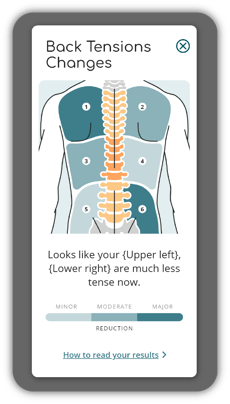In this article, we'll discuss the Back Tension Tracking Results and how to best understand them.
The Back Tension Tracking (BTT) data displayed on your screen is designed to be visually intuitive, making it easier for you to understand the information provided.
The results are divided into Major, Moderate, and Minor/No Change.
The darker green color represents a Major change to the back tension between the beginning and end of the session.
Moderate and Minor/No Change improvements are shown in lighter shades of green.

Assume you receive your BackHug for the very first time. During the first 20-minute session, our data analysis software collects and analyzes back tension data to establish a baseline for future BTT calculations. The more sessions you undergo, the more accurate your BTT results will become.
Your baseline will be continuously updated based on the average of your last five sessions. For example, if you completed your 10th BackHug session, the results will be based on the average data from sessions 4 - 9.
How Does Back Tension Tracking Work?
Without delving too deep into the technicalities, here's a general overview of how BTT functions:![]()
At the core of BTT are BackHug's 26 human-sized robotic fingers, each powered by a motorized mechanism. These fingers encounter varying levels of resistance as they move, influenced by factors such as clothing, muscle tissue, and bone structure. This, in turn, affects the electrical power needed for each movement. A sophisticated data analysis program collects, processes, and extracts valuable insights from this information.
We collect data at the beginning and end of each session and then compare the two data sets.
What Factors Could Influence the Accuracy of my Results?
The precision of BTT's data can be influenced by a multitude of variables. These include the time of day you partake in the session, changes to your body weight, the thickness of your clothing and the number of layers you have on. Your positioning on the device can also impact the data accuracy.
Should I Expect Major Improvements After Each BackHug Session?
It's more complex than that, and the level of improvement depends on the baseline tension in your back. For example, if a particular area in your back doesn't have much tension in the first place, it makes sense that there will be little change to the back tension data after the BackHug session. In that case, it will be likely that BTT displays Minor/No Change for that zone after a BackHug session.
If I Use BackHug Regularly, Will It Show Reduction In Back Tension Over Time?
![]()
With consistent use of the BackHug device, the tension levels in your back, as indicated by the BTT data, could show a gradual decrease. This might be reflected in your "My Back Tension progress" moving from categories of Major or Moderate to Minor over time.
However, the effectiveness of the BackHug treatment is not solely dependent on the device's usage but is also influenced by your lifestyle choices. For example, if you spend time sitting for several hours a day, due to intense work, the stress your body undergoes may undo all the good work the BackHug treatment does for you. As a result, although, every time you get on BackHug, it reduces your back tension, your neck & back tension may still remain high according to the BTT results. Additionally, the frequency and intervals between your BackHug sessions, as well as the factors previously discussed can affect the results.